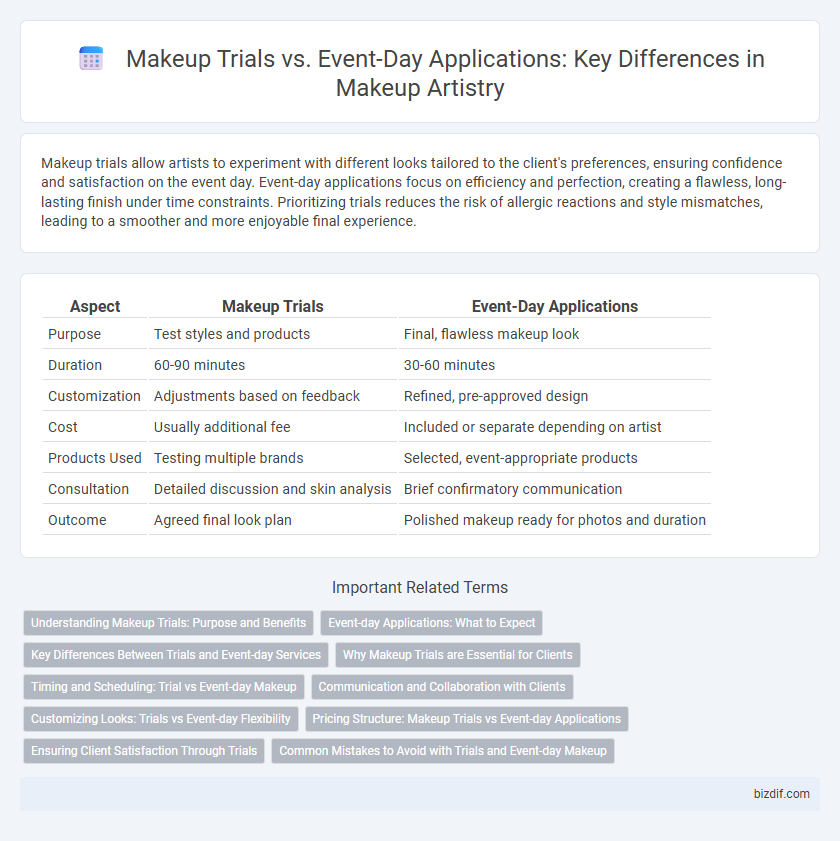Makeup trials allow artists to experiment with different looks tailored to the client's preferences, ensuring confidence and satisfaction on the event day. Event-day applications focus on efficiency and perfection, creating a flawless, long-lasting finish under time constraints. Prioritizing trials reduces the risk of allergic reactions and style mismatches, leading to a smoother and more enjoyable final experience.
Table of Comparison
| Aspect | Makeup Trials | Event-Day Applications |
|---|---|---|
| Purpose | Test styles and products | Final, flawless makeup look |
| Duration | 60-90 minutes | 30-60 minutes |
| Customization | Adjustments based on feedback | Refined, pre-approved design |
| Cost | Usually additional fee | Included or separate depending on artist |
| Products Used | Testing multiple brands | Selected, event-appropriate products |
| Consultation | Detailed discussion and skin analysis | Brief confirmatory communication |
| Outcome | Agreed final look plan | Polished makeup ready for photos and duration |
Understanding Makeup Trials: Purpose and Benefits
Makeup trials allow artists and clients to collaborate on desired looks, ensuring the final application matches expectations and complements skin tone, facial features, and event lighting. These sessions help identify products that perform well under different conditions, minimizing risks of allergic reactions or makeup failures on the event day. Understanding the purpose and benefits of makeup trials reduces stress and guarantees a polished, long-lasting finish tailored to the occasion.
Event-day Applications: What to Expect
Event-day makeup applications prioritize long-lasting wear and flawless finishes tailored to the specific lighting and conditions of your event, ensuring photos and videos capture your best look. Professional makeup artists use high-quality, smudge-proof products and techniques designed to withstand heat, humidity, and extended wear. Expect a streamlined process that focuses on enhancing your natural features, offering touch-ups as needed to maintain perfect results throughout the event.
Key Differences Between Trials and Event-day Services
Makeup trials emphasize experimentation with colors, techniques, and styles to achieve the perfect look tailored to the client's preferences, allowing ample time for adjustments. Event-day applications prioritize efficiency and flawless execution under time constraints, ensuring long-lasting wear and photo-ready results. Trials allow collaboration and confidence-building, while event-day services focus on precision and durability for the special occasion.
Why Makeup Trials are Essential for Clients
Makeup trials are essential for clients to ensure the final look aligns perfectly with their vision, skin type, and event theme, reducing the risk of unexpected outcomes on the event day. These sessions allow makeup artists to test products for skin sensitivity and longevity, ensuring durability under varied lighting and weather conditions. Trials also provide a valuable opportunity for client feedback and adjustments, guaranteeing confidence and satisfaction on the big day.
Timing and Scheduling: Trial vs Event-day Makeup
Makeup trials typically take 60 to 90 minutes, allowing artists to experiment with different looks and gather client feedback to ensure satisfaction. Event-day applications usually last about 45 minutes, emphasizing efficiency while maintaining flawless results under tighter time constraints. Scheduling trials at least two weeks before the event day provides ample time for adjustments and finalizing the perfect makeup style.
Communication and Collaboration with Clients
Effective communication during makeup trials ensures the artist understands the client's preferences, skin concerns, and event requirements, leading to tailored looks that align with the client's vision. Trials provide a collaborative environment for feedback, allowing adjustments in products, techniques, and styles to perfect the final application. Clear dialogue between makeup artist and client minimizes risks of dissatisfaction on the event day and builds trust, ensuring a seamless and confident makeup experience.
Customizing Looks: Trials vs Event-day Flexibility
Makeup trials allow artists to customize and perfect a client's look by testing various styles, colors, and techniques in advance, ensuring the final design aligns with the client's vision. Event-day applications require flexibility to adapt subtle changes based on lighting, outfit, or client feedback while maintaining the core look established during the trial. This balance between pre-planned customization and real-time adjustments is crucial for flawless, personalized makeup artistry.
Pricing Structure: Makeup Trials vs Event-day Applications
Makeup trials typically have a distinct pricing structure that reflects the detailed customization and experimentation involved, often set at a fixed rate or a percentage of the event-day cost. Event-day applications are usually charged based on the final agreed-upon look, focusing on efficiency and precision, with some artists offering package deals that combine trial and event-day fees. Understanding the differentiation in pricing helps clients budget appropriately, ensuring professional expertise is tailored to both the trial session and the actual event.
Ensuring Client Satisfaction Through Trials
Makeup trials provide a crucial opportunity for artists to customize looks based on client preferences, skin type, and event lighting, ensuring flawless results on the event day. Through detailed consultations during trials, potential issues with product reactions or color mismatches are identified and resolved, enhancing client confidence and satisfaction. Event-day applications benefit from this thorough preparation by minimizing stress and delivering a polished, tailored finish that meets client expectations.
Common Mistakes to Avoid with Trials and Event-day Makeup
Makeup trials often suffer from rushed application and insufficient communication, leading to mismatched foundation tones and untested products that cause allergic reactions on the event day. Event-day makeup mistakes usually include unblended edges, cakey layers, and failure to account for long-lasting wear in different lighting conditions. Avoiding these errors requires detailed trial sessions, patch testing, and using high-quality, durable cosmetics tailored to the event environment.
Makeup Trials vs Event-day Applications Infographic

 bizdif.com
bizdif.com